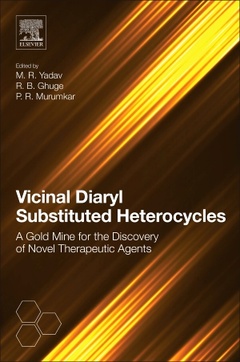Description
Vicinal Diaryl Substituted Heterocycles
A Gold Mine for the Discovery of Novel Therapeutic Agents
Coordinators: Yadav M. R., Murumkar P. R., Ghuge R. B.
Language: English
Subjects for Vicinal Diaryl Substituted Heterocycles:
Keywords
Imidazoles; 1; 2; 4-oxadiazole; 1; 2; 5-oxadiazole; 1; 4-Diaryl azetidin-2-ones; 15-Lipoxygenase inhibitors; ACAT/SOAT inhibitors; AChE inhibitors; AcylCoAcholesterolacyltransferase inhibitors; Analgesic; Analgesics; Anti-Alzheimer; Antibacterial; Anticancer; ÂAnticancer; Anti-cancer; Anticancer agents; Anticoccidial agents; Antifungal; Anti-HIV; Antihypercholesterolemic; Antiinflammatory; Anti-inflammatory; Anti-inflammatory agents; Antimicrobial; Antimicrobial agents; Antinociceptive agents; Anti-obesity; Antioxidant; Antiproliferative; Anti-proliferative agents; Antithrombotic agents; Antitubercular; Antitubercular agents; Aspartylprotease inhibitors; B-ÂRafkinase inhibitors; CB1 receptor antagonists; CB1 receptor inverse agonists; Cholesterol absorption inhibitory; COX inhibitors; COX-2 inhibitor; COX-2 inhibitors; Diaryl chromane; Diaryl heteroaryl pyrimidine; Diaryl heteroaryl thiazole; Diaryl Âheteroaryl-fused pyridine; Diaryl indole; Diaryl purine; Diaryl quinoline; Diaryl quinoxaline; Diaryl tetrazoles; Diaryl thiophenes; Estrogenic; Ezetimibe; Imidazolines; Isoselenazoles; Isoxazole; LOX inhibitors; Oxazole; Rofecoxib; Selective COX-2 inhibitors; Selective estrogen receptor modulators; Selendiazoles; Six/seven-membered vicinal diaryl heterocycles; Thiadiazoles; Thiazolidinones; Thiazolines; Valdecoxib; Vicinal diaryl; Vicinal diaryl furan; Vicinal diaryl fused heterocyclics; Vicinal diaryl heterocycles; Vicinal diaryl pyrazoles; Vicinal diaryl pyrroles; Vicinal diaryl thiazoles; Vicinal diaryl triazoles; β-Lactam
430 p. · 19x23.3 cm · Paperback
Description
/li>Contents
/li>Readership
/li>Biography
/li>Comment
/li>
Vicinal Diaryl-Substituted Heterocycles: A Gold Mine for the Discovery of Novel Therapeutic Agents draws together all of the key information about these compounds in one place for the first time. Following an informative overview of the importance of these structures to the discovery of potential therapeutic agents, the text goes on to outline the main compound types, with each chapter focusing on the activities of a different structure. Designed to support researchers by consolidating this important information in a single, practical guide, the authors hope to encourage further advancement and development in the discovery of novel therapeutic agents.
As flexible building blocks for the production of novel compounds, vicinal diaryl-substituted heterocycles are a rich source of leads for the development of new drugs. Their adaptability means that they can be used to produce structures with a broad range of attractive characteristics, and a large number of vicinal diaryl-substituted heterocyclic compounds have already been synthesized and investigated by medicinal chemists as promising lead molecules.
1. Vicinal Diaryl Heterocyclic System: A Privileged Scaffold in the Discovery of Potential Therapeutic Agents 2. Therapeutic Potential of Vicinal Diaryl Azetidin-2-ones 3. Vicinal Diaryl Pyrroles: Synthesis and Biological Aspects 4. Synthesis and Biological Profiles of 4, 5-, 1, 5- and 1, 2-Diaryl-1H-imidazoles 5. Vicinal Diaryl Pyrazole: A Therapeutically Potential Molecular Scaffold 6. Vicinal Diaryl Triazoles and Tetrazoles 7. Synthesis and Biological Activities of Vicinal Diaryl Furans 8. Vicinal Diaryl Thiazoles and Thiadiazoles 9. Vicinal Diaryl Oxadiazoles, Oxazoles and Isoxazoles 10. Chemical and Biological Profiles of Vicinal Diaryl-substituted Thiophenes, Imidazolines, Selendiazoles and Isoselenazoles 11. Synthesis and Biological Significance of Six- and Seven-membered Vicinal Diaryl Heterocycles 12. Biological Spectrum of Vicinal Diaryl-substituted Fused Heterocycles
Medicinal chemists working on heterocycle-based drugs in both academic and commercial settings, as well as organic chemists, pharmaceutical scientists, combinatorial chemists and biochemists
Dr. Murumkar is Assistant Professor of Pharmaceutical Chemistry in the Faculty of Pharmacy at The Maharaja Sayajirao University of Baroda. Dr. Murumkar is a recipient of ICMR International Fellowship award for young Indian Bio-medical Scientist for the year 2018-19. He has worked as visiting scientist at Karolinska Institute, Division of Translational Alzheimer Neurobiology, Stockholm, Sweden for the period of Jan-July 2017. In addition to receiving a National Doctoral Fellowship during his doctoral work, he was awarded multiple Young Scientist Travel Grants from a number of different government agencies, including Department of Science & Technology (DST), Council of Scientific and Industrial Research (CSIR), and the Indian Council of Medical Research (ICMR), facilitating the presentation of his research work at the 235th and 245th ACS National meetings held in New Orleans in 2008 and 2013 respectively, and the 237th meet
- Collects together details of the key vicinal diaryl-substituted heterocyclic compounds in one place for the first time
- Highlights biological activities and SAR of derivatives
- Structured practically for ease of navigation between different derivatives




